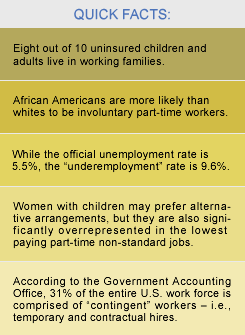

 |

|
 Interview with David Williams, Harvard School of Public Health Williams talks about the health effects of job loss and about what policies might help protect workers' physical and mental well-being. ARTICLES Generally speaking, workers in non-standard jobs have worse health than full-time employed workers but are better off than those who are unemployed. Compared to standard employees, workers in non-standard jobs are generally paid less, have little or no job security, have less control over their schedules, are often mismatched in terms of tasks and skills, have higher rates of injury, and are less likely to receive adequate training. They are also more likely to be discriminated against, have fewer legal protections, and are much less likely to have health insurance or qualify for sick leave and paid vacation.

The vulnerabilities of non-standard work produce a cascade of direct and indirect health effects. Having insufficient income threatens diet, housing and the availability of other critical resources. For families, this can disrupt childcare and eldercare and create marital strife. Shift work disrupts the body’s natural rhythms, both increasing and prolonging stress levels. Over the long term, acute stress can become chronic, leading to heart disease and other life-threatening conditions. Inadequate training and mismatched skills produce anxiety and job strain, and increase injury risk. Job uncertainty and involuntary job loss are associated with higher levels of disease risk, anxiety, depression, alcohol abuse, and child maltreatment. The net effect of this increased insecurity and chaos in people’s lives is a burden shared by all: increased health care costs, increased disability, increased costs to the welfare system, increased crime rates, divorce, and other social consequences. As Kathy Stone writes in From Widgets to Digits, all employment has become precarious: even a small percentage (5-10%) of nonstandard work arrangements in an industry or firm creates insecurity for all workers. |
|
|||
|